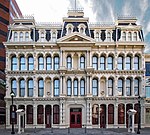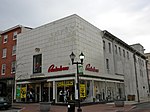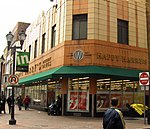Govatos'/McVey Building

Govatos'/McVey Building is a historic commercial building located at Wilmington, New Castle County, Delaware. It was built in 1895, and is a three-story, rectangular plan building of bearing wall brick construction. During the first half of the 20th century, it was converted into a restaurant, candy factory/shop by removing original storefronts along East Eighth Street. The building features large half-hexagonal pedimented copper bays on the second and third stories in the Queen Anne style. The building has housed Govatos Chocolates since 1910–1918. Govatos is the last candy making firm in Wilmington and still makes hand-dipped candy by the same method as in 1894.It was added to the National Register of Historic Places in 1985.
Excerpt from the Wikipedia article Govatos'/McVey Building (License: CC BY-SA 3.0, Authors, Images).Govatos'/McVey Building
Alico Road, Wilmington
Geographical coordinates (GPS) Address Nearby Places Show on map
Geographical coordinates (GPS)
| Latitude | Longitude |
|---|---|
| N 39.743368 ° | E -75.548848 ° |
Address
Downtown Wilmington Commercial Historic District
Alico Road
19801 Wilmington
Delaware, United States
Open on Google Maps











